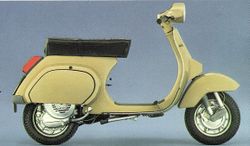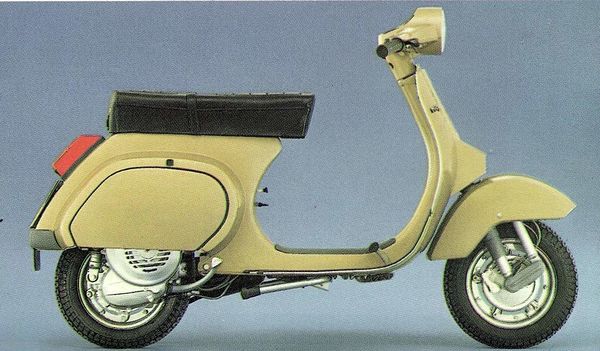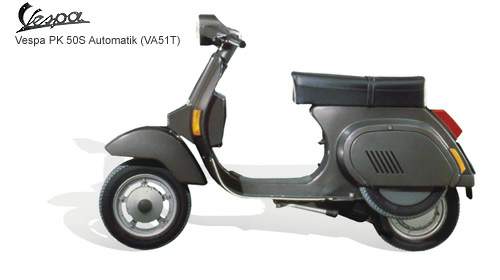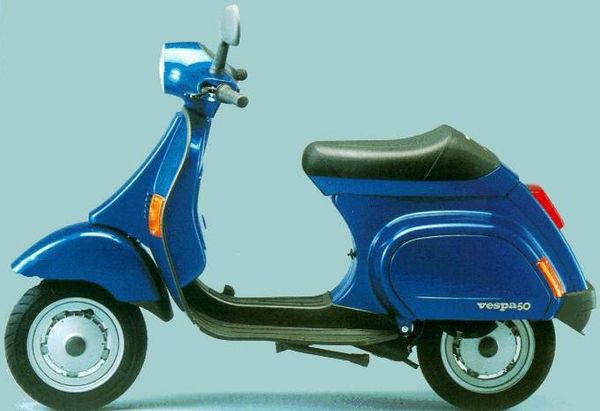Vespa PK50 Models
 |
|
| Vespa PK50 Models | |
| Manufacturer | |
|---|---|
| Production | 1982 - 93 |
| Engine | Two stroke, single cylinder |
| Compression ratio | 9.1:1 |
| Top Speed | 70 km/h / 43.5 mph |
| Ignition | Flywheel magneto |
| Spark Plug | Bosch W225 T1 |
| Battery | 1 x 6V - 9.5 Ah batteries |
| Transmission | 4 Speed, grip shift |
| Frame | Pressed sheet steel with streamlined monocoque structure |
| Suspension | Front: Trailing arm, coil spring, damper Rear: Coil spring, damper |
| Brakes | Front: 150 mm drum Rear: 150 mm drum |
| Front Tire | 3 x 10" |
| Rear Tire | 3 x 10" |
| Wheelbase | 1175 mm / 46.5 in |
| Weight | 77 kg / 169.7 lbs (dry), |
| Fuel Capacity | 6.2 L / 1.6 US gal |
| Manuals | Service Manual |
It could reach a top speed of 70 km/h / 43.5 mph.
Engine[edit | edit source]
The engine was a Air cooled with centrifugal fan cooled Two stroke, single cylinder. The engine featured a 9.1:1 compression ratio.
Drive[edit | edit source]
Power was moderated via the Oil bath, multi plate.
Chassis[edit | edit source]
It came with a 3 x 10" front tire and a 3 x 10" rear tire. Stopping was achieved via 150 mm drum in the front and a 150 mm drum in the rear. The front suspension was a Trailing arm, coil spring, damper while the rear was equipped with a Coil spring, damper. The PK50 Models was fitted with a 6.2 L / 1.6 US gal fuel tank. The bike weighed just 77 kg / 169.7 lbs. The wheelbase was 1175 mm / 46.5 in long.
Photos[edit | edit source]
Overview[edit | edit source]
The Vespa 50 was launched in 1963 in response to regulatory changes in Italy. By 2002, the Vespa 50 and its variants had sold roughly 1.42 million units across the world. This is a remarkable success for a vehicle which was launched to escape the regulatory constraints more than anything else. The popularity of small body Vespa has grown through the decades. With the introduction of Highway code in 1962, vehicles larger than 50cc were required to have a license plate. 14 years and above were allowed to ride scooters under 50cc without a license. Young riders who till then was a small share was rapidly becoming mobile and affluent. Vespa 50 circumvented the regulatory challenge and opened a hew world for the youngsters. The marketing campaign revolved around this. Giovane, moderna e senza documenti or Young, modern and without papers The 50SS (or 50 Super Sprint from 1971) was a 50cc version of the 90SS with an elongated chrome exhaust and spare wheel located vertically on the platform with a glovebox fitted on top of the wheel.
| Make Model | Vespa PK 50, PK50S, PK50 Elestart, PK50XL, PK50XLS, PK50 |
|---|---|
| Year | 1982 - 93 |
| Engine Type | Two stroke, single cylinder |
| Displacement | 49.8 cc / 3.0 cub in |
| Bore X Stroke | 38.4 x 43 mm |
| Compression | 9.1:1 |
| Mixture | 1:50 |
| Carburettor | Dell'Orto SHB 16/10 |
| Cooling System | Air cooled with centrifugal fan |
| Battery | 1 x 6V - 9.5 Ah batteries |
| Induction | Rotary valve |
| Ignition | Flywheel magneto |
| Starting | Kick start |
| Spark Plug | Bosch W225 T1 |
| Clutch | Oil bath, multi plate |
| Max Power | 2.7 kW / 3.7 Hp @ 7000 rpm |
| Transmission | 4 Speed, grip shift |
| Gear Ratios | 1st 26.88 / 2nd 17.74 / 3rd 12.78 / 4th 9.62:1 |
| Final Drive | Direct drive |
| Frame | Pressed sheet steel with streamlined monocoque structure |
| Front Suspension | Trailing arm, coil spring, damper |
| Rear Suspension | Coil spring, damper |
| Front Brakes | 150 mm drum |
| Rear Brakes | 150 mm drum |
| Wheels | Pressed steel flanges, interchangeable |
| Front Tire | 3 x 10" |
| Rear Tire | 3 x 10" |
| Dimensions | Length: 1675 mm / 65.9 in Width: 700 mm / 27.6 in Height: 1070 mm / 42.0 in |
| Wheelbase | 1175 mm / 46.5 in |
| Ground Clearance | 252 mm / 9.9 in |
| Dry Weight | 77 kg / 169.7 lbs |
| Fuel Capacity | 6.2 L / 1.6 US gal |
| Reserve | 1.2 L / 0.32 US gal |
| Consumption Average | 3.5 L/100 km / 29 km/l / 68 US mpg |
| Top Speed | 70 km/h / 43.5 mph |
| Source | vesparade.worldpress.com, Wikipedia, Vespa by Giorgio Sarti |


